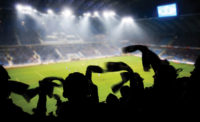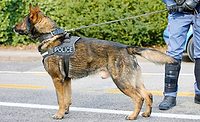Keeping Fans Safe
The National Football League is committed to keeping our fans, players, coaches and employees safe when working in our facilities. Under the leadership of NFL Commissioner Roger Goodell, the teams have provided a great deal of support to NFL Security Department initiatives designed to create a safe environment for all who attend our games during the season. The efforts of many stadium professionals behind the scenes are key to the success of our Stadium Security and Fan Conduct programs.
One thing we have learned from our fans is that they value the stadium environment (sense of security, fan conduct, stadium cleanliness) as the second most important part of the stadium experience behind, of course, on-field play. Our fans want to feel safe and be protected from those that might act in a way that would ruin their NFL experience. Since we value our fans’ game day experience and realize that our stadiums present a potential target for terrorism, we have taken aggressive steps to secure our venues and to address negative fan behavior.
One thing we have learned from our fans is that they value the stadium environment (sense of security, fan conduct, stadium cleanliness) as the second most important part of the stadium experience behind, of course, on-field play. Our fans want to feel safe and be protected from those that might act in a way that would ruin their NFL experience. Since we value our fans’ game day experience and realize that our stadiums present a potential target for terrorism, we have taken aggressive steps to secure our venues and to address negative fan behavior.
In December 2008 the U.S. Department of Homeland Security designated the NFL Best Practices for Stadium Security as a Qualified Anti-Terrorism Technology pursuant to the Support Anti-terrorism by Fostering Effective Technologies Act of 2002 (the Safety Act). This certification was the culmination of a rigorous examination and evaluation of the NFL Stadium Security program that had its genesis immediately following the terrorist attacks of 9/11.
The NFL Best Practices for Stadium Security is a written set of security recommendations and guidelines that each club is asked to execute both inside and outside of their stadiums. The Best Practices applies to both game day and non-game day security procedures at our stadiums. It focuses on everything from facility hardening, electronic monitoring, threat assessment/emergency preparedness, HVAC, stadium access and packages/deliveries to staffing levels, gate access procedures, pat down searches, vehicle screening and credentials.
The successful execution of our Stadium Security program depends upon trained staff at each facility carrying out their job responsibilities in a consistent manner each and every day in alignment with our Best Practices guidelines. This includes law enforcement personnel, contract security professionals, guest services, ushers and medical personnel, to name just a few. We conduct unannounced stadium security reviews at every stadium across the league each season and prepare detailed reports rating each club on how well they adhered to our Best Practices guidelines. It is critical that our stadium security team understand what is expected of them and that they all work together seamlessly to administer our security protocols. To that end, the NFL Security Department hosts an annual training seminar for lead law enforcement agency personnel, team security directors, stadium security managers and team fan conduct points of contact for each club. The annual training seminar helps to ensure that everyone understands what we did well this past season and where we need to improve as we prepare for the upcoming season. Through relentless follow-up and assessment and dynamic training sessions where peers learn from each other, we aim to improve and refine our security posture at our stadiums each year.
In August 2008, Commissioner Goodell launched the Fan Conduct initiative by requiring that all clubs take certain steps designed to promote an enjoyable game day experience for all fans. One of the steps required of all clubs was to develop, promote and publish a Club Fan Code of Conduct to establish fan expectations and create a positive environment for all fans, including families and children. The Code instructed fans that the following behaviors would not be tolerated:
• Behavior that is unruly, disruptive or illegal in nature.
• Intoxication or other signs of alcohol or substance impairment that results in irresponsible behavior.
• Foul or abusive language or obscene gestures.
• Interference with the progress of the game (including throwing objects on to the field).
• Failing to follow the instructions of stadium personnel.
• Verbal or physical harassment of opposing team fans.
In an effort to support the new Fan Code of Conduct, we developed the Best Practices for Fan Conduct. Similar to the approach taken on the stadium security side, these written recommendations cover a multitude of topics such as publication of the Code, having a Code infraction schedule, alcohol management/training, rapid response teams, designated driver programs and managing tailgate and parking areas. We have partnered with Mothers Against Drunk Driving and TEAM Coalition to assist in creating better alcohol awareness among our fans as we believe that fans can choose to use alcohol responsibly. Each club submits a detailed Fan Conduct game report to the NFL Security Department following every home game that encompasses number of arrests, ejections, time and location of fan conduct incidents. We engage an independent auditing firm to conduct reviews of each stadium to determine how well they have implemented our Best Practices recommendations. We also use a research firm to conduct between 250-350 fan intercept surveys of fans in and around every stadium to learn how our fans rate club performance in proactively addressing negative fan behavior at their stadiums. These results are then used to provide detailed ratings reports to every team owner depicting how well their club has done in implementing their Fan Conduct program, and how they measure up to other clubs throughout the league.
• Intoxication or other signs of alcohol or substance impairment that results in irresponsible behavior.
• Foul or abusive language or obscene gestures.
• Interference with the progress of the game (including throwing objects on to the field).
• Failing to follow the instructions of stadium personnel.
• Verbal or physical harassment of opposing team fans.
In an effort to support the new Fan Code of Conduct, we developed the Best Practices for Fan Conduct. Similar to the approach taken on the stadium security side, these written recommendations cover a multitude of topics such as publication of the Code, having a Code infraction schedule, alcohol management/training, rapid response teams, designated driver programs and managing tailgate and parking areas. We have partnered with Mothers Against Drunk Driving and TEAM Coalition to assist in creating better alcohol awareness among our fans as we believe that fans can choose to use alcohol responsibly. Each club submits a detailed Fan Conduct game report to the NFL Security Department following every home game that encompasses number of arrests, ejections, time and location of fan conduct incidents. We engage an independent auditing firm to conduct reviews of each stadium to determine how well they have implemented our Best Practices recommendations. We also use a research firm to conduct between 250-350 fan intercept surveys of fans in and around every stadium to learn how our fans rate club performance in proactively addressing negative fan behavior at their stadiums. These results are then used to provide detailed ratings reports to every team owner depicting how well their club has done in implementing their Fan Conduct program, and how they measure up to other clubs throughout the league.
Our fans have really embraced this new initiative in many ways. One of the most valuable tools we have found in our efforts to improve fan behavior is the use of text messaging. In the past, fans experiencing a problem had to leave their seat and attempt to locate an usher to assist them. This action also exposed them to potential reprisals as the offending fan may have observed them leave to report the violation. The beauty of text messaging is that it can be done from a fan’s seat without missing the game. It is quick and effective in relaying information and does not draw any unwanted attention to the fan seeking assistance. Best of all, the offending fan has no idea where a complaint could come from and this in and of itself serves as a form of deterrence. Our Best Practices requests that all clubs use a text messaging system to track each complaint from receipt through final disposition. We also recommend the use of fixed signage inside of the seating bowl that clearly explains how to send a text message requesting help for a fan conduct issue.
Through greater publication of text messaging during the 2009 season, we received 7,299 text messages on fan conduct issues; almost doubling the number we received during the first year of the program. This allowed our stadium security personnel to respond to many incidents before they got out of hand and required an arrest or ejection. The text messaging component shows our fans that we truly value their in-stadium experience because we are providing them with a means to communicate immediately when they need help. It is our goal to provide timely customer service by solving their problem so they can go about enjoying the game with family and friends.
The NFL is working hard to enhance the game day experience of our fans by taking concrete actions designed to increase safety and security while improving the environment by removing negative fan behavior problems. In this way, we hope to encourage all of our fans to enjoy the exciting stadium experience our game offers without ruining that experience for others.
Looking for a reprint of this article?
From high-res PDFs to custom plaques, order your copy today!




